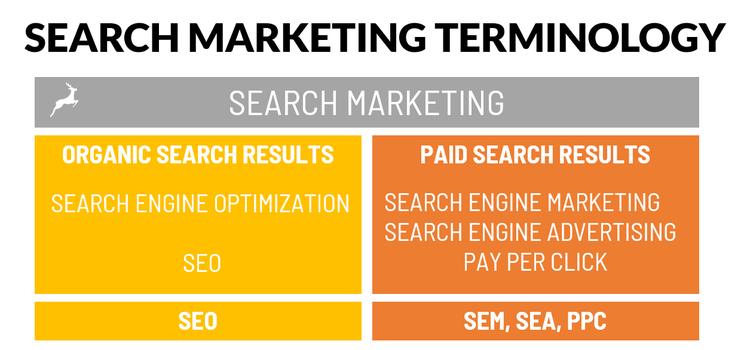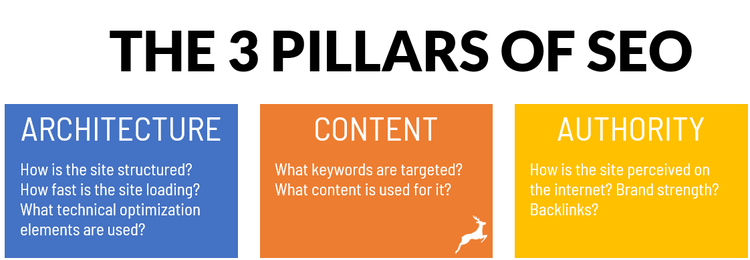SEO is an acronym for search engine optimization, also called organic search. SEM stands for search engine marketing, but most people use it to designate search engine advertising, also called paid search.
SEO is a form of marketing in connection with search engines too, and both organic and paid search could be considered as search engine marketing.

SEM is short for search engine marketing and really is the overarching name for organic and paid search, but it's commonly used to designate search engine advertising. Image source: Author
Looking closer at these two types of search marketing, they both concentrate on presenting a website's content when users input keywords in search engines.
SEO versus SEM, organic versus paid search: These two marketing techniques appear in the same communication channel. But are they friends or enemies?
What is search engine optimization (SEO)?
Search engine optimization is a set of techniques to improve SEO visibility: getting your website to show up in search engines when users search for specific keywords.
SEO techniques fall into three pillars: architecture, covering aspects of technical SEO; content, covering keywords and written content; and authority, covering mainly link building.

There are three pillars of SEO: architecture, content, and authority. Each requires a different approach and skillset. Image source: Author
What is search engine marketing (SEM)?
Search engine marketing is advertising which appears on search engine results pages after users have input search queries. When talking about SEM, it is essentially the same as PPC, pay per click advertising.
Search engine advertising is mainly composed of text-based ads targeted to keywords. From a marketing perspective, SEO versus SEM is the difference between two economic models and two types of placements in the search engines results pages.
SEO vs. SEM: What's the difference?
Organic search and paid search are similar because they appear on the same media, the search engine search results page. Doing keyword research for SEO can be helpful for SEM, and vice versa. In the same manner, certain SEO tools can be helpful for paid search advertising. It also works the other way, as SEO benchmarks and value estimations are relevant for paid search data.
Despite sharing the same media and a few techniques and tools, there are many differences between the two types of search marketing.
1. One is consulting, the other advertising
SEO services are primarily offered on a consulting basis because there is hardly ever one straightforward solution to any website's challenge. SEM is advertising where you pay for exposure.
2. One is paid hourly, the other is on commission
Most SEO is paid on an hourly basis as a consulting service. It's common to add success fees to the mix. SEM is an advertising service that is preparation intensive. It is common to charge a commission of the media spend, but setup fees are a common addition.
3. One can take time, the other can be fast
Getting SEO results quickly is not impossible, but it's not the general rule. Most organic search projects start slowly, take ages to complete, and deliver results eventually. SEM traffic, on the other hand, can start in a matter of hours, although a more common rule is a week or two.
4. One is losing real estate, the other is gaining territory
Search engines are finding more ways to advertise their main real estate: the search results page. This means there's less space for organic search results and more for advertising. Search engines earn more money, but SEOs have a harder time justifying their fees than before, despite the same work efforts.
5. One can be inexpensive, the other can be bottomless
Sometimes people call SEO free traffic to your website. That ignores the fees an SEO provider can charge you. Still, SEO can be inexpensive, especially if you do most of it yourself, rely on off-the-shelf CMS solutions, and concentrate on the most essential tasks.
SEM can be a bottomless pit, as with most advertising. In principle, there's a limited inventory of searches for the keywords you are interested in, but click prices are ever-increasing, and search engines are constantly finding ways to expand exposure.
SEO vs. SEM: Which should you use?
A lot of discussion in the industry centers on whether paid search cannibalizes organic traffic. Most studies show it effectively does, but they also show that combining the two generates better results than relying solely on SEO. Let's look at some use cases.
When SEO is right for you
SEO results are always good, but it can be a challenge to generate tangible results from additional resources you invest in improving SEO. Here are some optimal times to invest SEO dollars.
- When you create a new website: SEO is marketing. If you create a new website without thinking about SEO, it won't have optimal visibility in search engines.
- At site launch: The technical site launch is the ideal time to do technical SEO, to make sure search engines will crawl and index your site correctly.
- If you never did SEO: Your business is running, and you have a website that drives some traffic, but you would like more. Doing an SEO audit can help you identify improvements that might generate more traffic to your website.
When paid search is right for you
Activating SEM for your website can accelerate your business. Here are instances when you should be turning to advertising in search engines.
- When your SEO works well: If you've created great SEO results, further investment would probably result in diminishing returns. In this case, paid search can be a great additional traffic source.
- When you need traffic fast: Traffic from search engines via advertising can start within a couple of hours from the moment you make the decision. SEO can take months to generate results.
- When you can monetize traffic: If each new visitor adds to your revenue, and you know the acquisition cost you can support for each new client, you are ready to plug into scalable SEM optimization.
Great alone but even better together
SEO and SEM are essentially two ways to create the same visibility, but best results typically come out of combining the two. It makes sense to start by optimizing SEO. It's a long-term traffic source that provides value on the basis of your initial investment. Once you see diminishing returns from your SEO investment, paid search can expand that same traffic significantly and continue the growth of your website traffic.
Our Small Business Expert
We're firm believers in the Golden Rule, which is why editorial opinions are ours alone and have not been previously reviewed, approved, or endorsed by included advertisers. The Ascent does not cover all offers on the market. Editorial content from The Ascent is separate from The Motley Fool editorial content and is created by a different analyst team.